Winterizing Your Home in Wisconsin
Winter in Wisconsin is no joke. With freezing temperatures, heavy snowfall, and icy conditions lasting for months, preparing your home for winter is essential to avoid costly repairs and ensure a comfortable, warm environment. Whether it’s your primary residence or a vacation home, winterizing will protect your property from harsh weather and help save on energy costs. In this guide, we’ll cover the steps you need to take to winterize both primary and vacation homes in Wisconsin.
Why Winterizing Your Wisconsin Home Is Important
1. Prevent Frozen Pipes
Frozen pipes are one of the most common and costly problems during Wisconsin winters. When water freezes inside pipes, it expands, which can cause the pipes to crack or burst. This can lead to significant water damage in your home and expensive repairs. By properly insulating and draining your pipes, you can avoid this risk.
2. Reduce Energy Costs
Cold winters can cause heating systems to work overtime, leading to higher energy bills. Winterizing your home by sealing drafts, upgrading insulation, and maintaining your heating system can reduce energy usage and lower costs, while keeping your home warm and comfortable.
3. Protect Your Roof and Gutters
Heavy snow and ice buildup can cause damage to your roof and gutters. Ice dams, in particular, can prevent water from draining properly, which can lead to leaks and structural damage. By preparing your roof and clearing gutters before winter, you can avoid these common issues.
4. Maintain Home Value
Homes that are not properly winterized are at greater risk for long-term damage, such as foundation cracks or water damage. Taking preventative steps protects your investment, whether it’s your primary residence or vacation home.
How to Winterize Your Primary Home in Wisconsin
1. Seal Drafts and Improve Insulation
Keeping cold air out and warm air in is the foundation of winterizing your home.
- Seal Windows and Doors: Check for drafts around windows and doors. Use weatherstripping, caulk, or foam insulation to seal any gaps. Even small drafts can lead to significant heat loss.
- Upgrade Insulation: Ensure that your attic, walls, and basement are well-insulated. Proper insulation keeps your home warm and reduces the energy needed to heat it. Consider upgrading insulation if it’s old or insufficient.
- Install Storm Windows and Doors: Storm windows and doors provide an extra layer of protection against the cold, helping reduce heat loss and protect against strong winter winds.
2. Protect Your Plumbing
Frozen pipes can cause major damage, so protecting them is a key part of winterizing your home.
- Insulate Pipes: Focus on pipes in unheated areas like basements, crawl spaces, or garages. Wrap them with foam insulation or heat tape to prevent freezing.
- Let Faucets Drip: During extreme cold, leave a slow drip on faucets connected to vulnerable pipes. This small flow of water helps prevent freezing.
3. Service Your Heating System
Your heating system will be working hard all winter, so make sure it’s up to the task.
- Furnace Tune-Up: Have your furnace inspected by a professional before the winter season. Change filters and make sure your system is running efficiently to avoid breakdowns.
- Test Thermostats: Ensure your thermostat is working properly. Consider upgrading to a programmable or smart thermostat to manage heating more efficiently and save on energy costs.
4. Prepare Your Roof and Gutters
Snow and ice can be tough on your roof and gutters. Take these steps to ensure they can handle the winter:
- Clean Gutters: Remove leaves, debris, and dirt from your gutters. Clean gutters ensure that melting snow and ice can drain properly, reducing the risk of ice dams.
- Inspect the Roof: Check for loose or damaged shingles and repair them before the first snowfall. Consider installing ice and water shields to prevent water from backing up under your roof shingles.
5. Check Safety Devices
- Smoke and Carbon Monoxide Detectors: Winter means increased use of heating systems and fireplaces, which can increase the risk of fires and carbon monoxide buildup. Test all detectors and replace the batteries if necessary.
- Fire Extinguishers: Keep fire extinguishers easily accessible, particularly near fireplaces and heating systems.
How to Winterize Your Vacation Home in Wisconsin
If you own a vacation home in Wisconsin that you won’t be visiting during the winter months, it’s essential to prepare it for the cold season. Since vacation homes are often left unoccupied for extended periods, they are at greater risk for damage from freezing temperatures, snow, and ice. Winterizing your vacation home ensures it stays protected while you’re away.
1. Turn Off the Water Supply
Frozen pipes can cause significant damage in an unoccupied home. The best way to prevent this is to shut off the water supply entirely.
- Shut Off the Main Water Valve: Locate your home’s main water valve and turn it off. This prevents water from flowing into the pipes while you’re not there.
- Drain the Plumbing System: After shutting off the water, open all faucets and flush toilets to drain any remaining water from the system. Don’t forget to drain the water heater and any exterior water lines as well.
- Add Antifreeze to Drains: Pour a small amount of non-toxic RV antifreeze into your sinks, toilets, and drains. This will prevent any residual water from freezing and damaging your pipes.
2. Adjust the Thermostat
Even though you won’t be living in your vacation home during the winter, you still need to maintain a minimum temperature to prevent freezing.
- Set the Thermostat: Set your thermostat to a minimum of 55°F to ensure that the indoor temperature stays above freezing. If you have a smart thermostat, you can monitor and adjust the temperature remotely.
- Monitor Energy Usage: A programmable thermostat can help you minimize energy usage while maintaining enough heat to protect the home.
3. Unplug Appliances and Electronics
Unplugging appliances and electronics not only saves energy but also protects them from potential power surges during winter storms.
- Unplug Non-Essential Items: Disconnect appliances such as TVs, microwaves, and computers to prevent damage from electrical surges caused by winter storms.
4. Secure the Home
A vacant home can be an attractive target for break-ins, so securing your property is a crucial part of winterizing.
- Install a Security System: Consider installing a security system with cameras and sensors that can be monitored remotely. This way, you can keep an eye on your home even when you’re not there.
- Use Timers for Lights: Set timers on indoor and outdoor lights to give the appearance that someone is home, deterring potential burglars.
- Notify a Neighbor or Property Manager: Let a trusted neighbor or property manager know that you won’t be around and ask them to check in on the property occasionally. If you hire a property manager, they can help manage any potential issues while you’re away.
5. Winterize Outdoor Areas
Just like your primary home, your vacation home’s exterior needs attention before winter hits.
- Store Outdoor Furniture: Move outdoor furniture, grills, and other equipment into storage to protect them from harsh winter conditions.
- Trim Trees and Branches: Snow and ice can weigh down tree branches, causing them to break and potentially damage your home. Trim any branches that hang over your home, driveway, or power lines.
Conclusion
Winterizing your home, whether it’s your primary residence or a vacation property, is essential for protecting it from the harsh Wisconsin winter. By following these steps, you can ensure your home is prepared for freezing temperatures, snow, and ice, saving you from costly repairs and energy bills. If you own a vacation home that will remain unoccupied for the season, taking extra precautions such as turning off the water supply and securing the property is crucial.
Whether you need help winterizing your current home or you’re looking to purchase a winter-ready property, Resilient Realty LLC is here to help. Contact us today for more information on how to protect your investment during the Wisconsin winter.





